Report: Digital Systems Management for New Campus Project, Chester Uni
VerifiedAdded on 2023/01/19
|8
|1916
|37
Report
AI Summary
This report provides a comprehensive overview of digital systems management, focusing on the development of a new system for a new campus project at Chester University. It begins by outlining the System Development Life Cycle (SDLC), detailing each phase from system planning and analysis to design, deployment, integration, testing, and maintenance. The report then explores different types of data at strategic, tactical, and operational levels, as well as the essential hardware and software required for IT management. Furthermore, it delves into various information systems, including Student Information Systems, Management Information Systems, Decision Support Systems, and Expert Systems, highlighting their roles and benefits. The report emphasizes the importance of Expert Systems and Decision Support Systems in enhancing business intelligence and supporting effective decision-making, particularly in complex organizational scenarios. The conclusion summarizes the key findings and emphasizes the need for effective digital systems management to improve performance and management within the university setting.
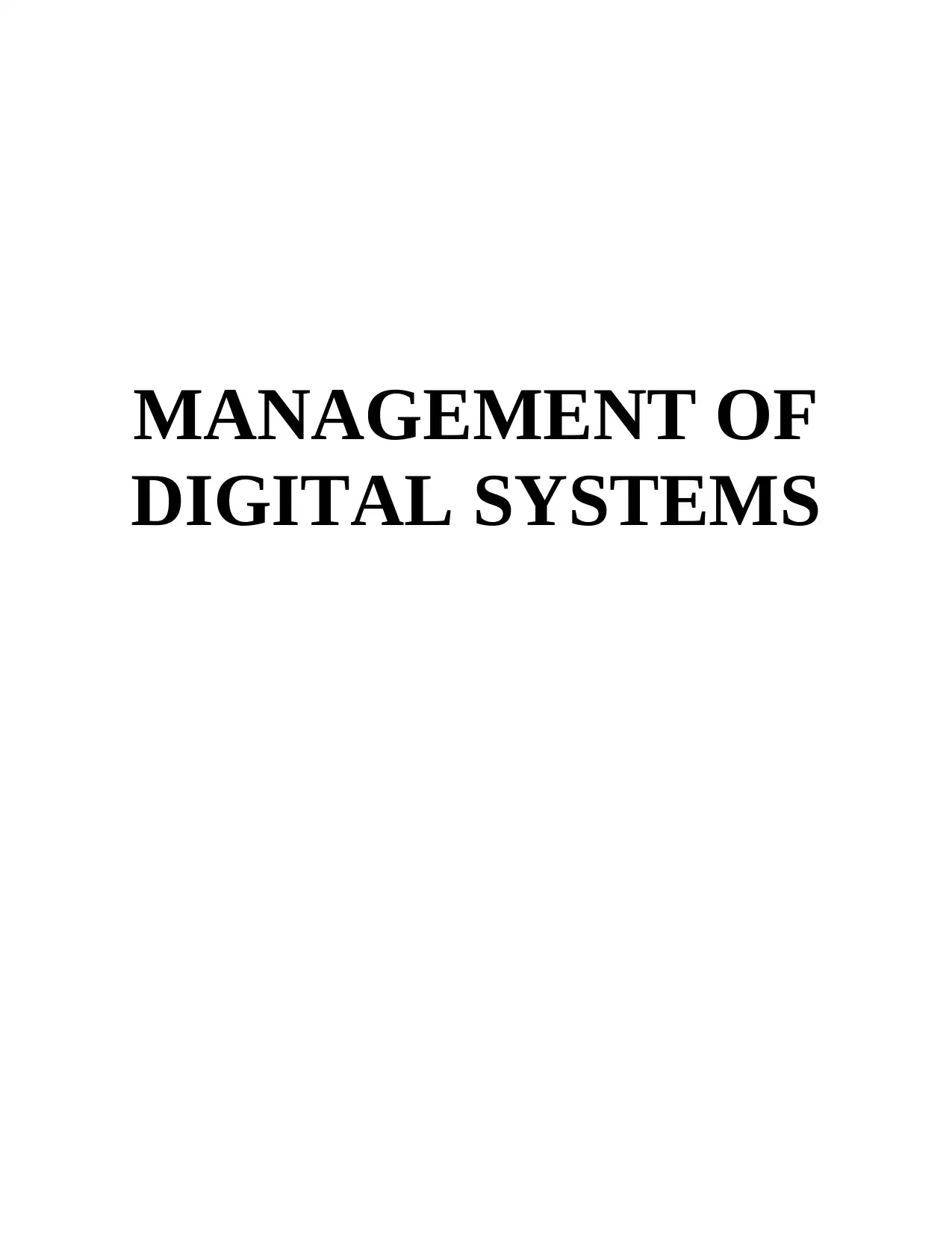
MANAGEMENT OF
DIGITAL SYSTEMS
DIGITAL SYSTEMS
Paraphrase This Document
Need a fresh take? Get an instant paraphrase of this document with our AI Paraphraser
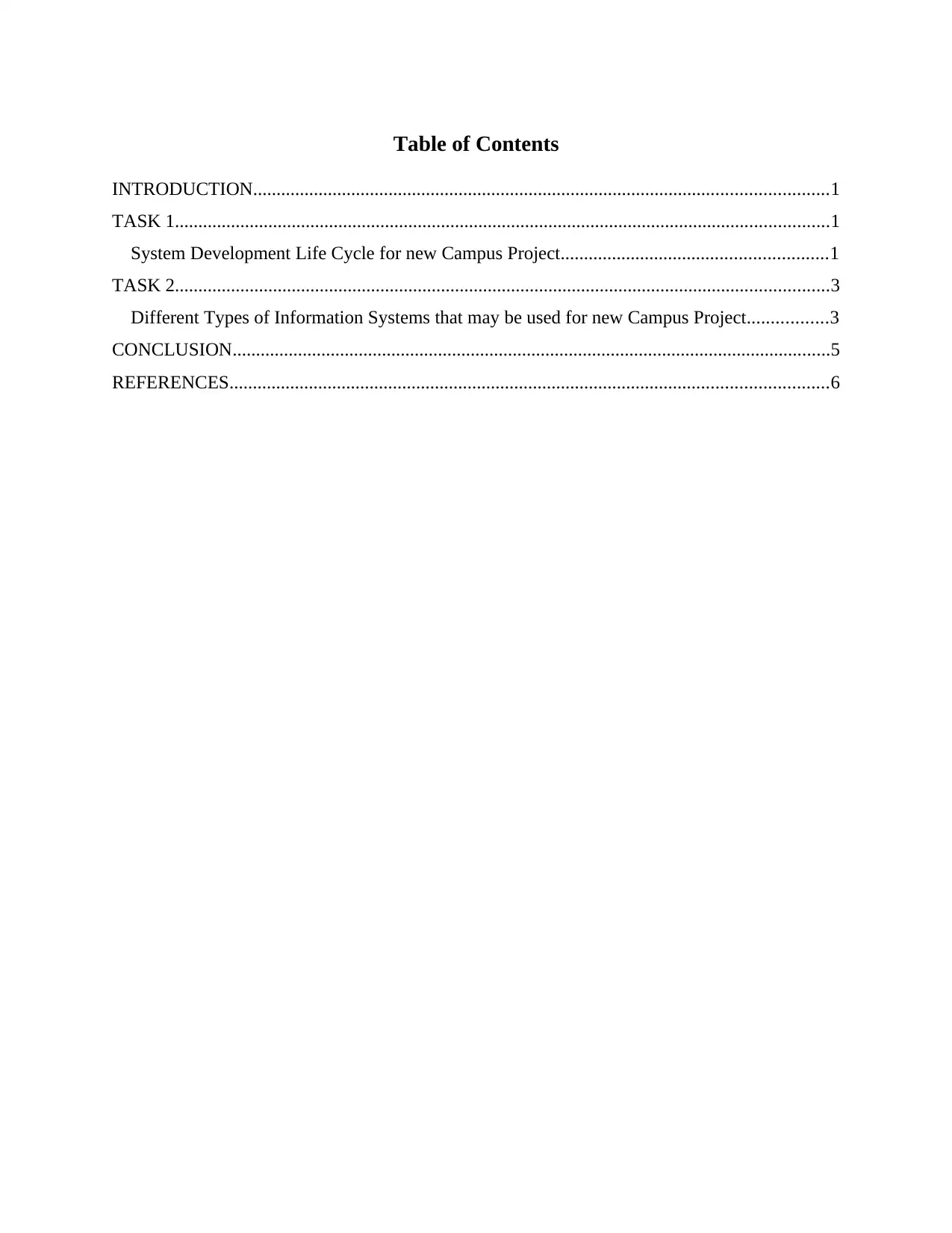
Table of Contents
INTRODUCTION...........................................................................................................................1
TASK 1............................................................................................................................................1
System Development Life Cycle for new Campus Project.........................................................1
TASK 2............................................................................................................................................3
Different Types of Information Systems that may be used for new Campus Project.................3
CONCLUSION................................................................................................................................5
REFERENCES................................................................................................................................6
INTRODUCTION...........................................................................................................................1
TASK 1............................................................................................................................................1
System Development Life Cycle for new Campus Project.........................................................1
TASK 2............................................................................................................................................3
Different Types of Information Systems that may be used for new Campus Project.................3
CONCLUSION................................................................................................................................5
REFERENCES................................................................................................................................6
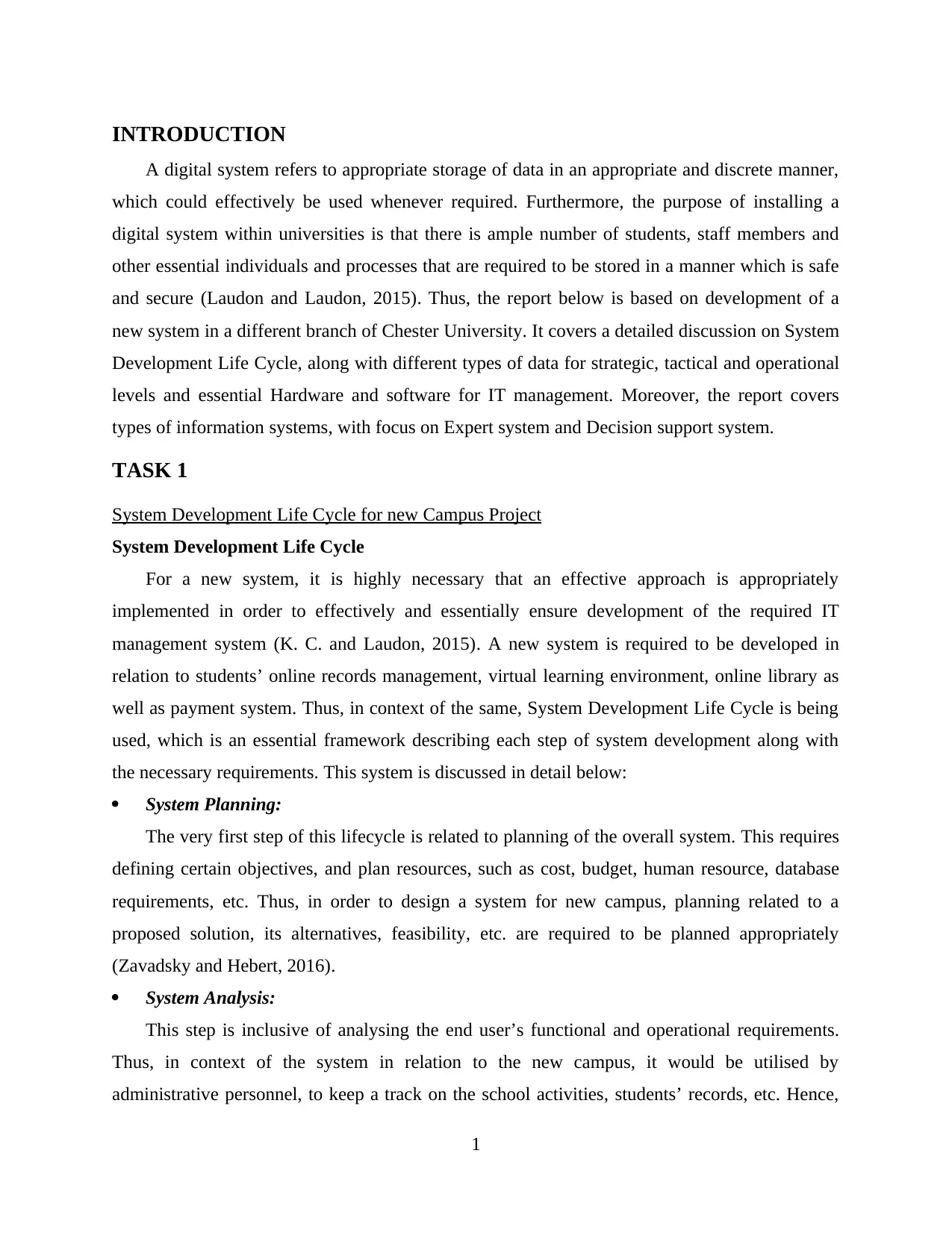
INTRODUCTION
A digital system refers to appropriate storage of data in an appropriate and discrete manner,
which could effectively be used whenever required. Furthermore, the purpose of installing a
digital system within universities is that there is ample number of students, staff members and
other essential individuals and processes that are required to be stored in a manner which is safe
and secure (Laudon and Laudon, 2015). Thus, the report below is based on development of a
new system in a different branch of Chester University. It covers a detailed discussion on System
Development Life Cycle, along with different types of data for strategic, tactical and operational
levels and essential Hardware and software for IT management. Moreover, the report covers
types of information systems, with focus on Expert system and Decision support system.
TASK 1
System Development Life Cycle for new Campus Project
System Development Life Cycle
For a new system, it is highly necessary that an effective approach is appropriately
implemented in order to effectively and essentially ensure development of the required IT
management system (K. C. and Laudon, 2015). A new system is required to be developed in
relation to students’ online records management, virtual learning environment, online library as
well as payment system. Thus, in context of the same, System Development Life Cycle is being
used, which is an essential framework describing each step of system development along with
the necessary requirements. This system is discussed in detail below:
System Planning:
The very first step of this lifecycle is related to planning of the overall system. This requires
defining certain objectives, and plan resources, such as cost, budget, human resource, database
requirements, etc. Thus, in order to design a system for new campus, planning related to a
proposed solution, its alternatives, feasibility, etc. are required to be planned appropriately
(Zavadsky and Hebert, 2016).
System Analysis:
This step is inclusive of analysing the end user’s functional and operational requirements.
Thus, in context of the system in relation to the new campus, it would be utilised by
administrative personnel, to keep a track on the school activities, students’ records, etc. Hence,
1
A digital system refers to appropriate storage of data in an appropriate and discrete manner,
which could effectively be used whenever required. Furthermore, the purpose of installing a
digital system within universities is that there is ample number of students, staff members and
other essential individuals and processes that are required to be stored in a manner which is safe
and secure (Laudon and Laudon, 2015). Thus, the report below is based on development of a
new system in a different branch of Chester University. It covers a detailed discussion on System
Development Life Cycle, along with different types of data for strategic, tactical and operational
levels and essential Hardware and software for IT management. Moreover, the report covers
types of information systems, with focus on Expert system and Decision support system.
TASK 1
System Development Life Cycle for new Campus Project
System Development Life Cycle
For a new system, it is highly necessary that an effective approach is appropriately
implemented in order to effectively and essentially ensure development of the required IT
management system (K. C. and Laudon, 2015). A new system is required to be developed in
relation to students’ online records management, virtual learning environment, online library as
well as payment system. Thus, in context of the same, System Development Life Cycle is being
used, which is an essential framework describing each step of system development along with
the necessary requirements. This system is discussed in detail below:
System Planning:
The very first step of this lifecycle is related to planning of the overall system. This requires
defining certain objectives, and plan resources, such as cost, budget, human resource, database
requirements, etc. Thus, in order to design a system for new campus, planning related to a
proposed solution, its alternatives, feasibility, etc. are required to be planned appropriately
(Zavadsky and Hebert, 2016).
System Analysis:
This step is inclusive of analysing the end user’s functional and operational requirements.
Thus, in context of the system in relation to the new campus, it would be utilised by
administrative personnel, to keep a track on the school activities, students’ records, etc. Hence,
1
⊘ This is a preview!⊘
Do you want full access?
Subscribe today to unlock all pages.

Trusted by 1+ million students worldwide
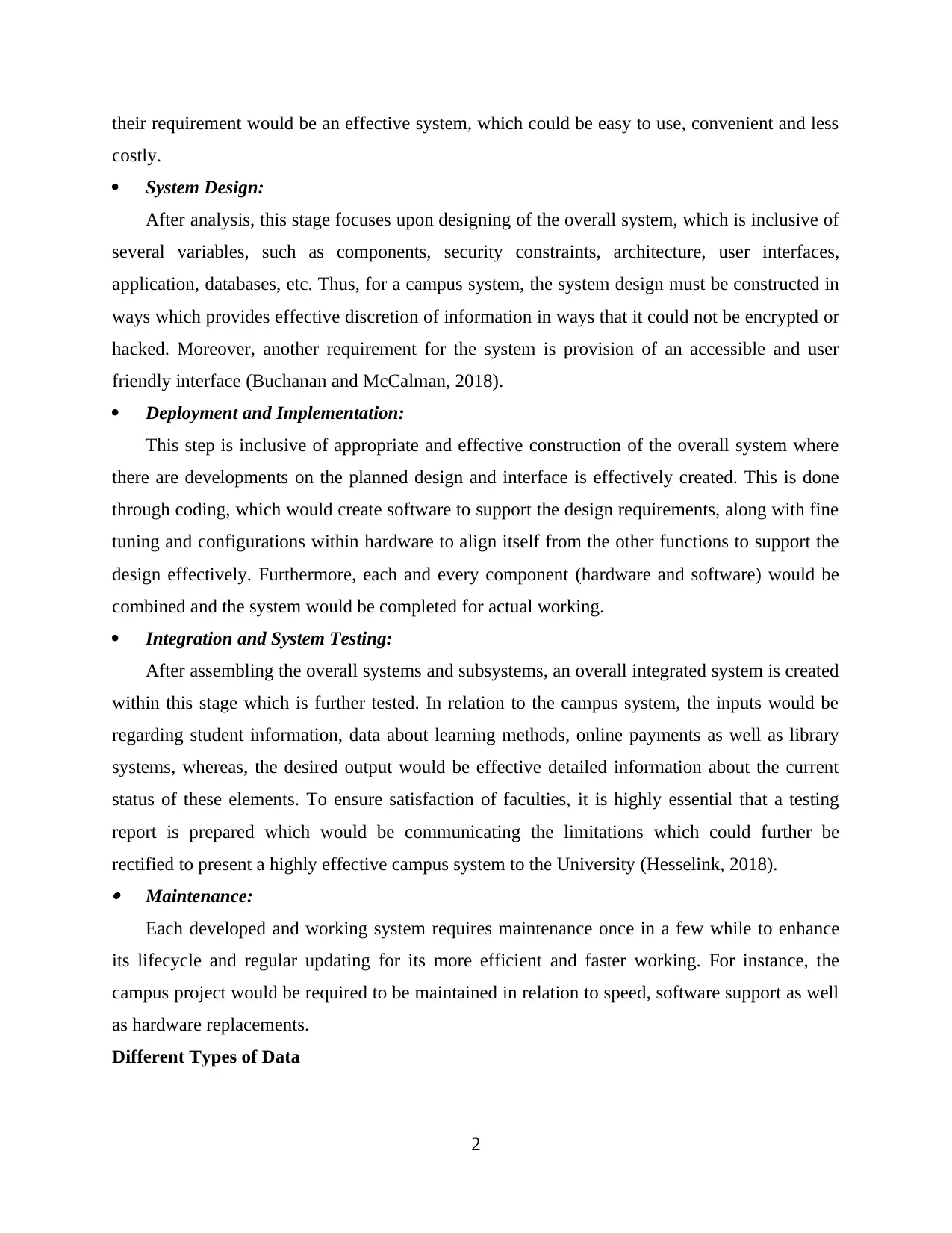
their requirement would be an effective system, which could be easy to use, convenient and less
costly.
System Design:
After analysis, this stage focuses upon designing of the overall system, which is inclusive of
several variables, such as components, security constraints, architecture, user interfaces,
application, databases, etc. Thus, for a campus system, the system design must be constructed in
ways which provides effective discretion of information in ways that it could not be encrypted or
hacked. Moreover, another requirement for the system is provision of an accessible and user
friendly interface (Buchanan and McCalman, 2018).
Deployment and Implementation:
This step is inclusive of appropriate and effective construction of the overall system where
there are developments on the planned design and interface is effectively created. This is done
through coding, which would create software to support the design requirements, along with fine
tuning and configurations within hardware to align itself from the other functions to support the
design effectively. Furthermore, each and every component (hardware and software) would be
combined and the system would be completed for actual working.
Integration and System Testing:
After assembling the overall systems and subsystems, an overall integrated system is created
within this stage which is further tested. In relation to the campus system, the inputs would be
regarding student information, data about learning methods, online payments as well as library
systems, whereas, the desired output would be effective detailed information about the current
status of these elements. To ensure satisfaction of faculties, it is highly essential that a testing
report is prepared which would be communicating the limitations which could further be
rectified to present a highly effective campus system to the University (Hesselink, 2018). Maintenance:
Each developed and working system requires maintenance once in a few while to enhance
its lifecycle and regular updating for its more efficient and faster working. For instance, the
campus project would be required to be maintained in relation to speed, software support as well
as hardware replacements.
Different Types of Data
2
costly.
System Design:
After analysis, this stage focuses upon designing of the overall system, which is inclusive of
several variables, such as components, security constraints, architecture, user interfaces,
application, databases, etc. Thus, for a campus system, the system design must be constructed in
ways which provides effective discretion of information in ways that it could not be encrypted or
hacked. Moreover, another requirement for the system is provision of an accessible and user
friendly interface (Buchanan and McCalman, 2018).
Deployment and Implementation:
This step is inclusive of appropriate and effective construction of the overall system where
there are developments on the planned design and interface is effectively created. This is done
through coding, which would create software to support the design requirements, along with fine
tuning and configurations within hardware to align itself from the other functions to support the
design effectively. Furthermore, each and every component (hardware and software) would be
combined and the system would be completed for actual working.
Integration and System Testing:
After assembling the overall systems and subsystems, an overall integrated system is created
within this stage which is further tested. In relation to the campus system, the inputs would be
regarding student information, data about learning methods, online payments as well as library
systems, whereas, the desired output would be effective detailed information about the current
status of these elements. To ensure satisfaction of faculties, it is highly essential that a testing
report is prepared which would be communicating the limitations which could further be
rectified to present a highly effective campus system to the University (Hesselink, 2018). Maintenance:
Each developed and working system requires maintenance once in a few while to enhance
its lifecycle and regular updating for its more efficient and faster working. For instance, the
campus project would be required to be maintained in relation to speed, software support as well
as hardware replacements.
Different Types of Data
2
Paraphrase This Document
Need a fresh take? Get an instant paraphrase of this document with our AI Paraphraser
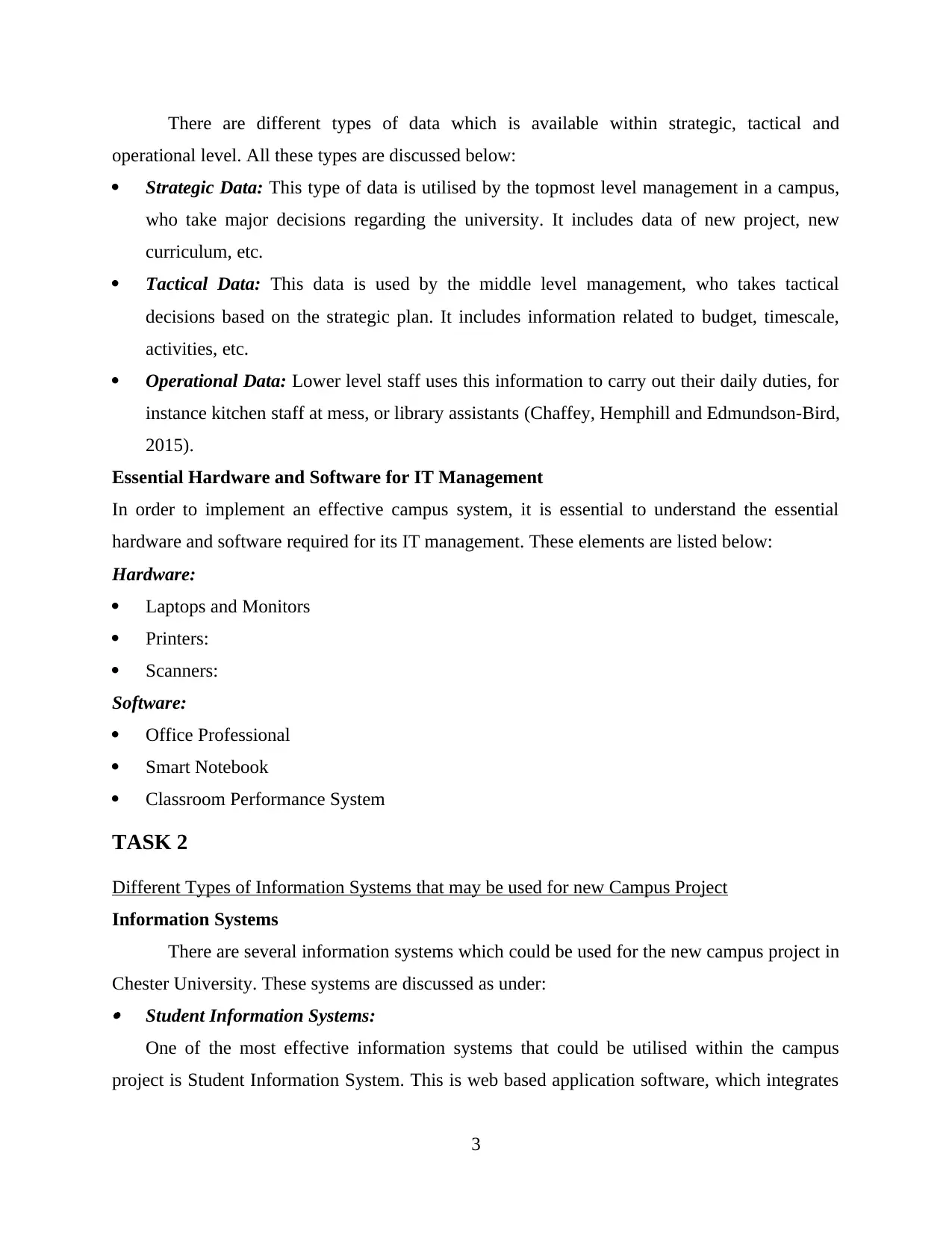
There are different types of data which is available within strategic, tactical and
operational level. All these types are discussed below:
Strategic Data: This type of data is utilised by the topmost level management in a campus,
who take major decisions regarding the university. It includes data of new project, new
curriculum, etc.
Tactical Data: This data is used by the middle level management, who takes tactical
decisions based on the strategic plan. It includes information related to budget, timescale,
activities, etc.
Operational Data: Lower level staff uses this information to carry out their daily duties, for
instance kitchen staff at mess, or library assistants (Chaffey, Hemphill and Edmundson-Bird,
2015).
Essential Hardware and Software for IT Management
In order to implement an effective campus system, it is essential to understand the essential
hardware and software required for its IT management. These elements are listed below:
Hardware:
Laptops and Monitors
Printers:
Scanners:
Software:
Office Professional
Smart Notebook
Classroom Performance System
TASK 2
Different Types of Information Systems that may be used for new Campus Project
Information Systems
There are several information systems which could be used for the new campus project in
Chester University. These systems are discussed as under: Student Information Systems:
One of the most effective information systems that could be utilised within the campus
project is Student Information System. This is web based application software, which integrates
3
operational level. All these types are discussed below:
Strategic Data: This type of data is utilised by the topmost level management in a campus,
who take major decisions regarding the university. It includes data of new project, new
curriculum, etc.
Tactical Data: This data is used by the middle level management, who takes tactical
decisions based on the strategic plan. It includes information related to budget, timescale,
activities, etc.
Operational Data: Lower level staff uses this information to carry out their daily duties, for
instance kitchen staff at mess, or library assistants (Chaffey, Hemphill and Edmundson-Bird,
2015).
Essential Hardware and Software for IT Management
In order to implement an effective campus system, it is essential to understand the essential
hardware and software required for its IT management. These elements are listed below:
Hardware:
Laptops and Monitors
Printers:
Scanners:
Software:
Office Professional
Smart Notebook
Classroom Performance System
TASK 2
Different Types of Information Systems that may be used for new Campus Project
Information Systems
There are several information systems which could be used for the new campus project in
Chester University. These systems are discussed as under: Student Information Systems:
One of the most effective information systems that could be utilised within the campus
project is Student Information System. This is web based application software, which integrates
3
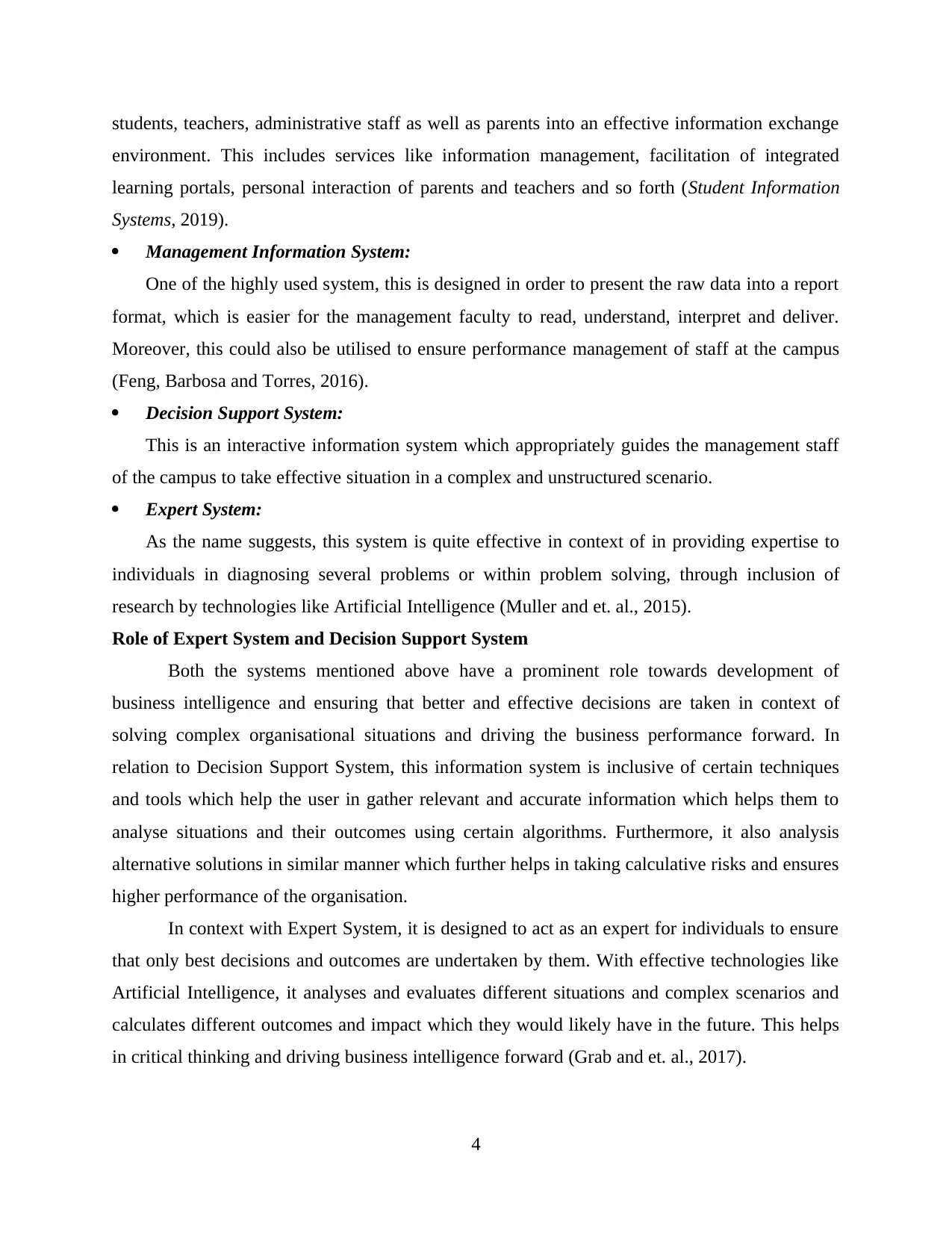
students, teachers, administrative staff as well as parents into an effective information exchange
environment. This includes services like information management, facilitation of integrated
learning portals, personal interaction of parents and teachers and so forth (Student Information
Systems, 2019).
Management Information System:
One of the highly used system, this is designed in order to present the raw data into a report
format, which is easier for the management faculty to read, understand, interpret and deliver.
Moreover, this could also be utilised to ensure performance management of staff at the campus
(Feng, Barbosa and Torres, 2016).
Decision Support System:
This is an interactive information system which appropriately guides the management staff
of the campus to take effective situation in a complex and unstructured scenario.
Expert System:
As the name suggests, this system is quite effective in context of in providing expertise to
individuals in diagnosing several problems or within problem solving, through inclusion of
research by technologies like Artificial Intelligence (Muller and et. al., 2015).
Role of Expert System and Decision Support System
Both the systems mentioned above have a prominent role towards development of
business intelligence and ensuring that better and effective decisions are taken in context of
solving complex organisational situations and driving the business performance forward. In
relation to Decision Support System, this information system is inclusive of certain techniques
and tools which help the user in gather relevant and accurate information which helps them to
analyse situations and their outcomes using certain algorithms. Furthermore, it also analysis
alternative solutions in similar manner which further helps in taking calculative risks and ensures
higher performance of the organisation.
In context with Expert System, it is designed to act as an expert for individuals to ensure
that only best decisions and outcomes are undertaken by them. With effective technologies like
Artificial Intelligence, it analyses and evaluates different situations and complex scenarios and
calculates different outcomes and impact which they would likely have in the future. This helps
in critical thinking and driving business intelligence forward (Grab and et. al., 2017).
4
environment. This includes services like information management, facilitation of integrated
learning portals, personal interaction of parents and teachers and so forth (Student Information
Systems, 2019).
Management Information System:
One of the highly used system, this is designed in order to present the raw data into a report
format, which is easier for the management faculty to read, understand, interpret and deliver.
Moreover, this could also be utilised to ensure performance management of staff at the campus
(Feng, Barbosa and Torres, 2016).
Decision Support System:
This is an interactive information system which appropriately guides the management staff
of the campus to take effective situation in a complex and unstructured scenario.
Expert System:
As the name suggests, this system is quite effective in context of in providing expertise to
individuals in diagnosing several problems or within problem solving, through inclusion of
research by technologies like Artificial Intelligence (Muller and et. al., 2015).
Role of Expert System and Decision Support System
Both the systems mentioned above have a prominent role towards development of
business intelligence and ensuring that better and effective decisions are taken in context of
solving complex organisational situations and driving the business performance forward. In
relation to Decision Support System, this information system is inclusive of certain techniques
and tools which help the user in gather relevant and accurate information which helps them to
analyse situations and their outcomes using certain algorithms. Furthermore, it also analysis
alternative solutions in similar manner which further helps in taking calculative risks and ensures
higher performance of the organisation.
In context with Expert System, it is designed to act as an expert for individuals to ensure
that only best decisions and outcomes are undertaken by them. With effective technologies like
Artificial Intelligence, it analyses and evaluates different situations and complex scenarios and
calculates different outcomes and impact which they would likely have in the future. This helps
in critical thinking and driving business intelligence forward (Grab and et. al., 2017).
4
⊘ This is a preview!⊘
Do you want full access?
Subscribe today to unlock all pages.

Trusted by 1+ million students worldwide
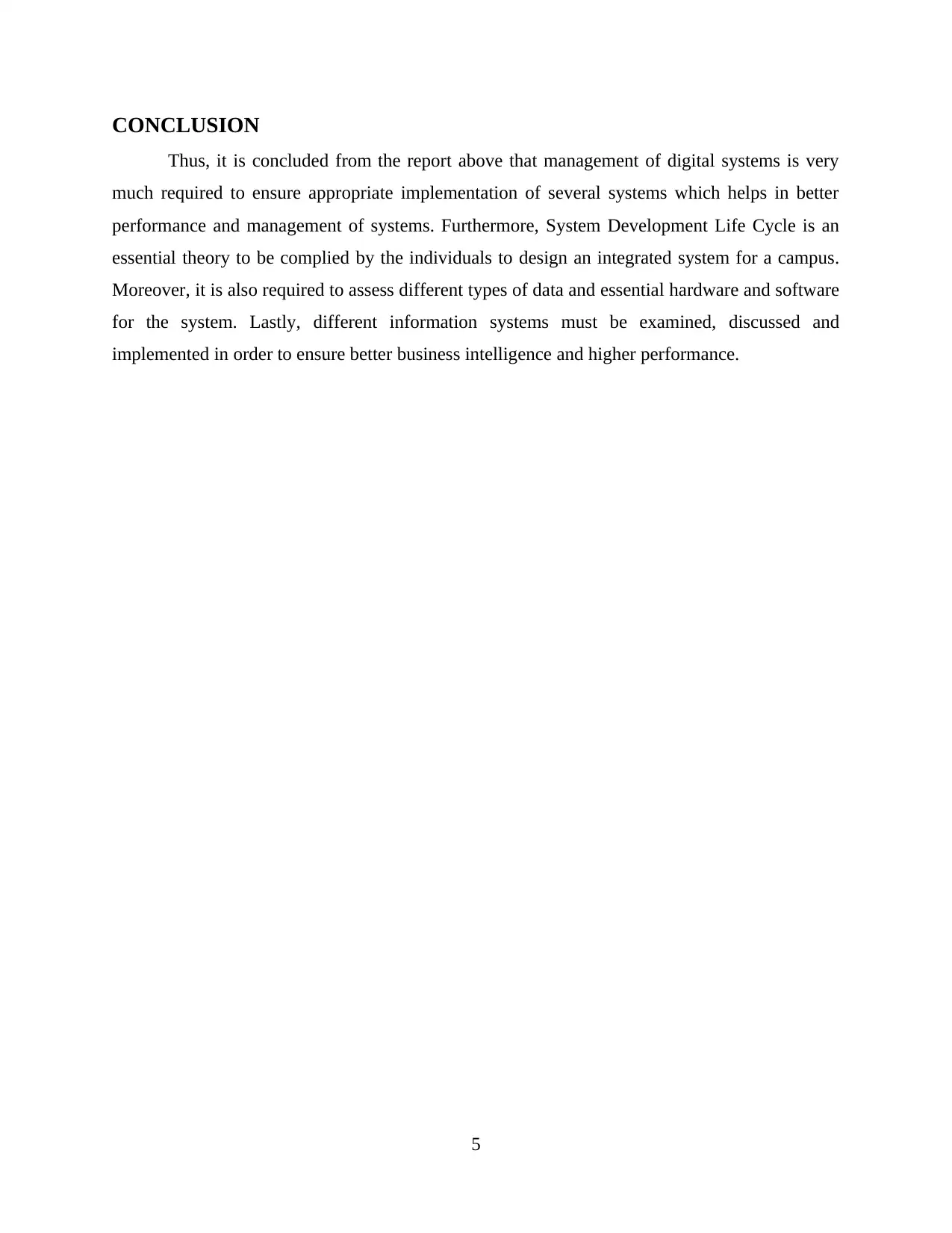
CONCLUSION
Thus, it is concluded from the report above that management of digital systems is very
much required to ensure appropriate implementation of several systems which helps in better
performance and management of systems. Furthermore, System Development Life Cycle is an
essential theory to be complied by the individuals to design an integrated system for a campus.
Moreover, it is also required to assess different types of data and essential hardware and software
for the system. Lastly, different information systems must be examined, discussed and
implemented in order to ensure better business intelligence and higher performance.
5
Thus, it is concluded from the report above that management of digital systems is very
much required to ensure appropriate implementation of several systems which helps in better
performance and management of systems. Furthermore, System Development Life Cycle is an
essential theory to be complied by the individuals to design an integrated system for a campus.
Moreover, it is also required to assess different types of data and essential hardware and software
for the system. Lastly, different information systems must be examined, discussed and
implemented in order to ensure better business intelligence and higher performance.
5
Paraphrase This Document
Need a fresh take? Get an instant paraphrase of this document with our AI Paraphraser

REFERENCES
Books and Journals
Buchanan, D. A., & McCalman, J. (2018). High performance work systems: The digital
experience. Routledge.
Chaffey, D., Hemphill, T., & Edmundson-Bird, D. (2015). Digital business and e-commerce
management. Pearson UK.
Feng, J., Barbosa, L. D. A., & Torres, V. (2016). U.S. Patent No. 9,262,517. Washington, DC:
U.S. Patent and Trademark Office.
Grab, E. W., & et. al. (2017). U.S. Patent No. 9,798,863. Washington, DC: U.S. Patent and
Trademark Office.
Hesselink, L., Western Digital Technologies Inc, 2018. Methods and systems for a personal
multimedia content archive. U.S. Patent 10,019,741.
Laudon, K. C., & Laudon, J. P. (2015). Management Information Systems: Managing the Digital
Firm Plus MyMISLab with Pearson eText--Access Card Package. Prentice Hall Press.
Laudon, K. C., & Laudon, J. P. (2015). Management Information Systems: Managing the
Digital Firm Plus MyMISLab with Pearson eText--Access Card Package. Prentice Hall
Press.
Muller, M. S., & et. al. (2015). U.S. Patent No. 9,009,076. Washington, DC: U.S. Patent and
Trademark Office.
Zavadsky, D., & Hebert, T. G. (2016). U.S. Patent No. 9,450,689. Washington, DC: U.S. Patent
and Trademark Office.
Online
Student Information Systems. 2019. [Online] Available Through:
<https://www.techlearning.com/news/student-information-systems>
6
Books and Journals
Buchanan, D. A., & McCalman, J. (2018). High performance work systems: The digital
experience. Routledge.
Chaffey, D., Hemphill, T., & Edmundson-Bird, D. (2015). Digital business and e-commerce
management. Pearson UK.
Feng, J., Barbosa, L. D. A., & Torres, V. (2016). U.S. Patent No. 9,262,517. Washington, DC:
U.S. Patent and Trademark Office.
Grab, E. W., & et. al. (2017). U.S. Patent No. 9,798,863. Washington, DC: U.S. Patent and
Trademark Office.
Hesselink, L., Western Digital Technologies Inc, 2018. Methods and systems for a personal
multimedia content archive. U.S. Patent 10,019,741.
Laudon, K. C., & Laudon, J. P. (2015). Management Information Systems: Managing the Digital
Firm Plus MyMISLab with Pearson eText--Access Card Package. Prentice Hall Press.
Laudon, K. C., & Laudon, J. P. (2015). Management Information Systems: Managing the
Digital Firm Plus MyMISLab with Pearson eText--Access Card Package. Prentice Hall
Press.
Muller, M. S., & et. al. (2015). U.S. Patent No. 9,009,076. Washington, DC: U.S. Patent and
Trademark Office.
Zavadsky, D., & Hebert, T. G. (2016). U.S. Patent No. 9,450,689. Washington, DC: U.S. Patent
and Trademark Office.
Online
Student Information Systems. 2019. [Online] Available Through:
<https://www.techlearning.com/news/student-information-systems>
6
1 out of 8
Related Documents
Your All-in-One AI-Powered Toolkit for Academic Success.
+13062052269
info@desklib.com
Available 24*7 on WhatsApp / Email
![[object Object]](/_next/static/media/star-bottom.7253800d.svg)
Unlock your academic potential
Copyright © 2020–2025 A2Z Services. All Rights Reserved. Developed and managed by ZUCOL.





